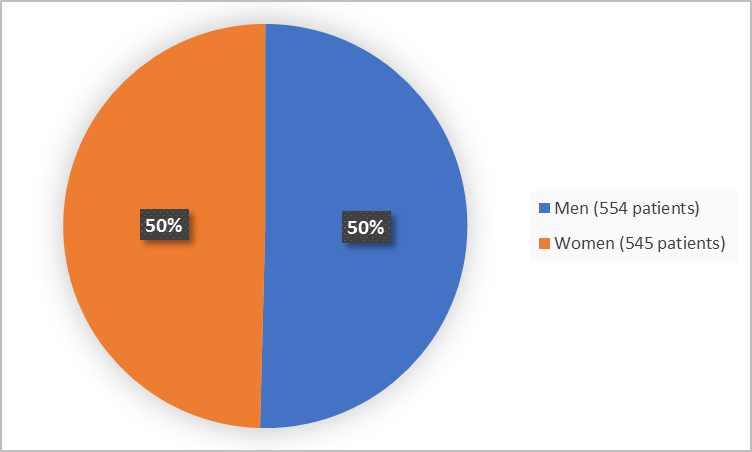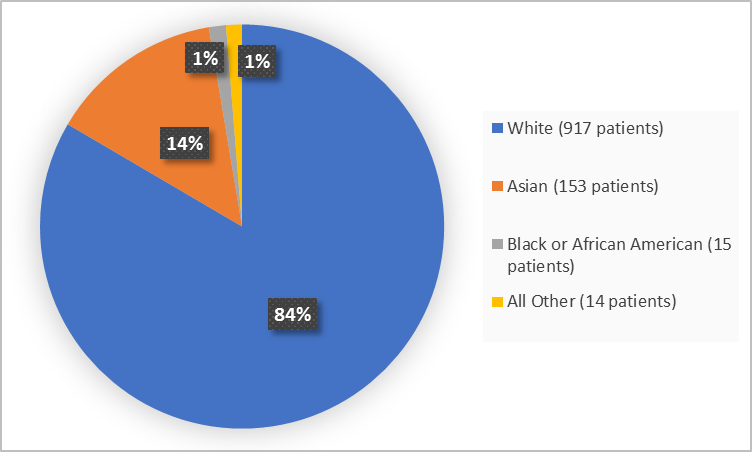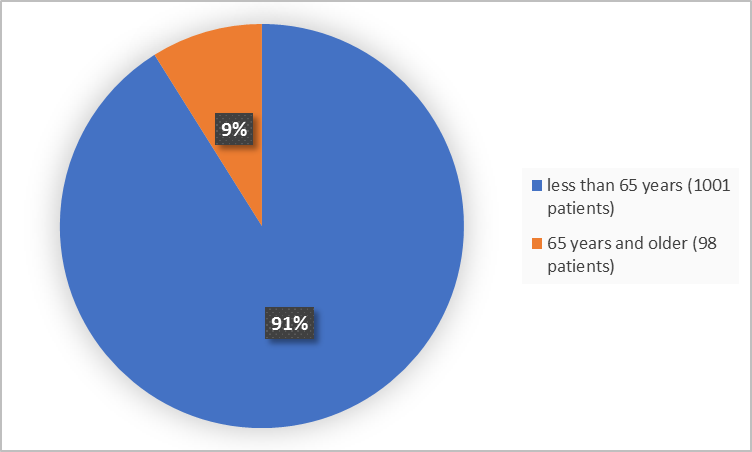Drug Trials Snapshots: AEMCOLO
HOW TO USE THIS SNAPSHOT
The information provided in Snapshots highlights who participated in the clinical trials that supported the FDA approval of this drug, and whether there were differences among sex, race and age groups. The “MORE INFO” bar shows more detailed, technical content for each section. The Snapshot is intended as one tool for consumers to use when discussing the risks and benefits of the drugs.
LIMITATIONS OF THIS SNAPSHOT:
Do not rely on Snapshots to make decisions regarding medical care. Always speak to your health provider about the risks and benefits of a drug. Refer to the AEMCOLO Package Insert for complete information.
AEMCOLO (rifamycin)
aim-COH-loh
Conventus BioMedical Solutions, Inc
Approval date: November 16, 2018
DRUG TRIALS SNAPSHOT SUMMARY:
What is the drug for?
AEMCOLO is a drug for the treatment of adult patients with travelers’ diarrhea which is
- caused by noninvasive type of Escherichia coli, and
- not complicated by fever or blood in the stool.
Travelers' diarrhea is a condition defined by having three or more unformed stools in 24 hours, in a person who is traveling.
How is this drug used?
Two tablets of AEMCOLO are taken by mouth twice daily for three days.
What are the benefits of this drug?
In the trial, patients who took AEMCOLO experienced shorter duration of diarrhea (by approximately 22 hours) in comparison to patients who took placebo.
What are the benefits of this drug (results of trials used to assess efficacy)?
The clinical efficacy of AEMCOLO was assessed using an endpoint of time to last unformed (watery or soft) stool (TLUS). The endpoint of clinical cure was defined as two or fewer soft stools and minimal enteric symptoms at the beginning of a 24-hour period or no unformed stools at the beginning of a 48-hour period.
Table 2. Clinical Response in Trial 1 (ITT Population)
|
|
AEMCOLO |
Placebo |
Difference |
P value |
|---|---|---|---|---|
|
Median TLUS (hrs) |
46.0 |
68.0 |
-22.0 |
p = 0.0008a |
|
Clinical cure, n (%) |
162 (81.4%) |
37 (56.9%) |
24.5% |
p <0.0001b |
ITT = Intent-to-Treat; TLUS = time to last unformed stool (in hours)
a log-rank test
b chi-square test, 95% confidence interval on the difference is (11.3, 37.7).
AEMCOLO Prescribing Information
Were there any differences in how well the drug worked in clinical trials among sex, race and age?
- Sex: AEMCOLO worked similarly in men and women.
- Race: The majority of patients in the trials were White. Differences in how well AEMCOLO worked among races could not be determined.
- Age: The majority of patients in the trials were younger than 65 years of age. Differences in how well AEMCOLO worked in patients younger and older than 65 years of age could not be determined.
Were there any differences in how well the drug worked in clinical trials among sex, race and age groups?
The table below summarizes the responses to AEMCOLO compared to placebo by subgroups based on ITT population in Trial 1. Age subgroups were not evaluated because of predominance of patients younger than 65 years of age.
Table 3. Subgroup Analyses of Median TLUS in ITT Population-Trial 1
|
|
|
Median TLUS (hours) |
||
|---|---|---|---|---|
|
Variable |
Subgroup |
AEMCOLO |
Placebo |
Difference |
|
Sex |
Women |
46.0 |
68.0 |
-22.0 |
|
Men |
46.0 |
64.0 |
-18.0 |
|
|
Race |
White |
46.0 |
68.3 |
-22.3 |
|
All Other |
45.4 |
56.4 |
-11.0 |
|
|
Ethnicity |
Hispanic/ Latino |
47.3 |
74.2 |
-26.9 |
|
Non-Hispanic/Latino |
45.5 |
67.6 |
-22.1 |
|
ITT=Intent to Treat; A=AEMCOLO; P=placebo
Adapted from FDA Review
What are the possible side effects?
The most common side effects are headache and constipation.
What are the possible side effects (results of trials used to assess safety)?
Summary of most frequent adverse reactions in the safety population from two trials is presented below.
In Trial 1 (placebo-controlled), the most common adverse reaction that occurred in at least 2% of AEMCOLO-treated patients (n = 199) and with an incidence higher than in the placebo group was constipation (3.5% AEMCOLO, 1.5% placebo)
In Trial 2 (active comparator), the most common adverse reaction that occurred in at least 2% of AEMCOLO-treated patients (n = 420) and with an incidence higher than in the ciprofloxacin group was headache (3.3% AEMCOLO, 1.9% ciprofloxacin)
AEMCOLO Prescribing Information
Were there any differences in side effects among sex, race and age?
- Sex: The occurrence of overall side effects was similar between men and women.
- Race: The majority of patients in the trials were White. Differences in side effects among races could not be determined.
- Age: The majority of patients in the trials were younger than 65 years of age. Differences in side effects between patients younger and older than 65 years of age could not be determined.
Were there any differences in side effects of the clinical trials among sex, race and age groups?
The table below summarizes adverse events by subgroups in the pooled trials.
Table 4. Summary of Treatment-Emergent Adverse Events by Subgroups in AEMCOLO treated patients - (Pooled trials)
|
|
Overall |
Sex |
Race |
Age |
||||
|---|---|---|---|---|---|---|---|---|
|
Men |
Women |
White |
Asian |
Others |
< 65 y |
≥ 65 y |
||
|
TEAEs |
191 |
80 |
111 |
171 |
9 |
11 |
182 |
9 |
Clinical Trial Data
WHO WAS IN THE CLINICAL TRIALS?
Who participated in the clinical trials?
The FDA approved AEMCOLO based on evidence from two clinical trials (Trial 1/ NCT01142089 and Trial 2/NCT01208922/) of 1099 patients with traveler’s diarrhea. The trials were conducted at 27 sites in India, Mexico, Guatemala, and Ecuador.
Trial 1 provided data to evaluate the benefit of AEMCOLO (efficacy population) and demographics of that trial population are presented in Table 6 under MORE INFORMATION.
Both trials provided data used to evaluate the side effects of AEMCOLO (safety population), and demographics of the safety population are presented below.
Figure 1 summarizes how many men and women were in the clinical trials used to evaluate the side effects (safety population).
Figure 1. Baseline Demographics by Sex (safety population)
Adapted from FDA Review
Figure 2 and Table 1 summarize the percentage of patients by race in the clinical trials.
Figure 2. Baseline Demographics by Race (safety population)
Adapted from FDA Review
Table 1. Baseline Demographics by Race
|
Race |
Number of Patients |
Percentage |
|---|---|---|
|
White |
917 |
84 |
|
Asian |
153 |
14 |
|
Black or African American |
15 |
1 |
|
American Indian or Alaska Native |
5 |
less than 1 |
|
Other |
9 |
1 |
Adapted from FDA Review
Figure 3 summarizes the percentage of patients by age in the clinical trials.
Figure 3. Baseline Demographics by Age (safety population)
Adapted from FDA Review
Who participated in the trials?
Table 5 below summarizes demographics of safety population from the trials.
Table 5. Demographics of Safety Population
|
Demographic |
Trial 1 |
Trial 2 |
Total |
||
|---|---|---|---|---|---|
|
AEMCOLO |
Placebo |
AEMCOLO |
Ciprofloxacin |
||
|
Sex |
|||||
|
Men |
99 (49.7) |
32 (49.2) |
205 (48.8) |
218 (52.5) |
554 (50.4) |
|
Women |
100 (50.3) |
33 (50.8) |
215 (51.2) |
197 (47.5) |
545 (49.6) |
|
Race |
|||||
|
White |
175 (87.9) |
56 (86.2) |
342 (81.4) |
344 (82.9) |
917 (83.4) |
|
Black or African American |
10 (5.0) |
5 (7.7) |
0 |
0 |
15 (1.3) |
|
Asian |
9 (4.5) |
1 (1.5) |
75 (17.9) |
68 (16.4) |
153 (13.9) |
|
American Indian or Alaska Native |
4 (2.0) |
1 (1.5) |
0 |
0 |
5 (0.5) |
|
Other |
1 (0.5) |
2 (3.1) |
3 (0.7) |
3 (0.7) |
9 (0.8) |
|
Age Group |
|||||
|
< 65 years |
196 (98.5) |
63 (96.9) |
378 (90.0) |
364 (87.7) |
1001 (91.1) |
|
≥ 65 years |
3 (1.5) |
2 (3.1) |
42 (10.0) |
51 (12.3) |
98 (8.9) |
|
Ethnicity |
|||||
|
Hispanic or Latino |
25 (12.6) |
6 (9.2) |
NR |
NR |
31 (2.8) |
|
Not Hispanic or Latino |
174 (87.4) |
59 (90.8) |
NR |
NR |
233 (21.2) |
|
Not Reported |
0 |
0 |
420 |
415 |
835 (76) |
|
Geographic Region |
|||||
|
India |
0 |
0 |
405 (96.4) |
400 (96.4) |
805 (73.2) |
|
Mexico |
131 (65.8) |
44 (67.7) |
0 |
0 |
175 (15.9) |
|
Guatemala |
68 (34.2) |
21 (32.3) |
14 (3.3) |
15 (3.6) |
118 (10.7) |
|
Ecuador |
0 |
0 |
1 (0.2) |
0 |
1 (0.1) |
NR=not reported
Adapted from FDA Review
Table 6 below summarizes demographics of efficacy population.
Table 6. Efficacy Population (Trial 1)
|
Demographic |
AEMCOLO |
Placebo |
Total |
|---|---|---|---|
|
Sex |
|||
|
Men |
99 (49.7) |
32 (49.2) |
131 (49.6) |
|
Women |
100 (50.3) |
33 (50.8) |
133 (50.4) |
|
Race |
|||
|
White |
175 (87.9) |
56 (86.2) |
231 (87.5) |
|
Black or African American |
10 (5.0) |
5 (7.7) |
15 (5.7) |
|
Asian |
9 (4.5) |
1 (1.5) |
10 (3.8) |
|
American Indian or Alaska Native |
4 (2.0) |
1 (1.5) |
5 (1.9) |
|
Other |
1 (0.5) |
2 (3.1) |
3 (1.1) |
|
Age |
|||
|
Mean years (SD) |
28.0 (11.4) |
28.9 (12.7) |
28.3 (11.7) |
|
Median (years) |
24 |
24 |
24 |
|
Min, max (years) |
18, 87 |
18, 72 |
18, 87 |
|
Age Group |
|||
|
< 65 years |
196 (98.5) |
63 (96.9) |
259 (98.1) |
|
≥ 65 years |
3 (1.5) |
2 (3.1) |
5 (1.9) |
|
Ethnicity |
|||
|
Hispanic or Latino |
25 (12.6) |
6 (9.2) |
31 (11.7) |
|
Not Hispanic or Latino |
174 (87.4) |
59 (90.8) |
233 (88.3) |
|
Geographic Region |
|||
|
Mexico |
131 (65.8) |
44 (67.7) |
175 (66.3) |
|
Guatemala |
68 (34.2) |
21 (32.3) |
89 (33.7) |
Adapted from FDA Review
How were the trials designed?
There were two trials that evaluated AEMCOLO in adults with travelers’ diarrhea.
Trial 1 one was used to evaluate efficacy and side effects of AEMCOLO in comparison to placebo. Patients were selected at random to use either two AEMCOLO tablets or placebo twice daily for three days. Neither the patients nor the health care providers knew which treatment was given until the end of the trial.
The trial compared AEMCOLO and placebo-treated patients by measuring the time to last watery or soft stool.
Trial 2 was primarily used to assess the side effects of AEMCOLO and to support the efficacy results from Trial 1. Patients were selected at random to use either AEMCOLO tablets or ciprofloxacin (an approved drug to treat infectious diarrhea) twice daily for three days. Neither the patients nor the health care providers knew which treatment was given until the end of the trial.
Trial 1 was multi-center, randomized, double-blind, placebo-controlled trial in adults with travelers’ diarrhea. Patients receive either 388 mg of AEMCOLO or placebo orally two times a day, for 3 days. Stool specimens were collected before treatment and 1 to 2 days following the end of treatment to identify enteric pathogens. The predominant pathogen was E. coli.
The clinical efficacy of AEMCOLO was assessed using an endpoint of time to last unformed (watery or soft) stool (TLUS) before achieving clinical cure. The endpoint of clinical cure was defined as two or fewer soft stools and minimal enteric symptoms at the beginning of a 24-hour period or no unformed stools at the beginning of a 48-hour period.
Trial 2 was a randomized, double-blind, multicenter, non-inferiority trial comparing AEMCOLO (200 mg twice daily for 3 days) versus ciprofloxacin (500 mg twice daily for 3 days). The results of Trial 2 were used as supportive evidence for Trial 2.
GLOSSARY
CLINICAL TRIAL: Voluntary research studies conducted in people and designed to answer specific questions about the safety or effectiveness of drugs, vaccines, other therapies, or new ways of using existing treatments.
COMPARATOR: A previously available treatment or placebo used in clinical trials that is compared to the actual drug being tested.
EFFICACY: How well the drug achieves the desired response when it is taken as described in a controlled clinical setting, such as during a clinical trial.
PLACEBO: An inactive substance or “sugar pill” that looks the same as, and is given the same way as, an active drug or treatment being tested. The effects of the active drug or treatment are compared to the effects of the placebo.
SUBGROUP: A subset of the population studied in a clinical trial. Demographic subsets include sex, race, and age groups.



